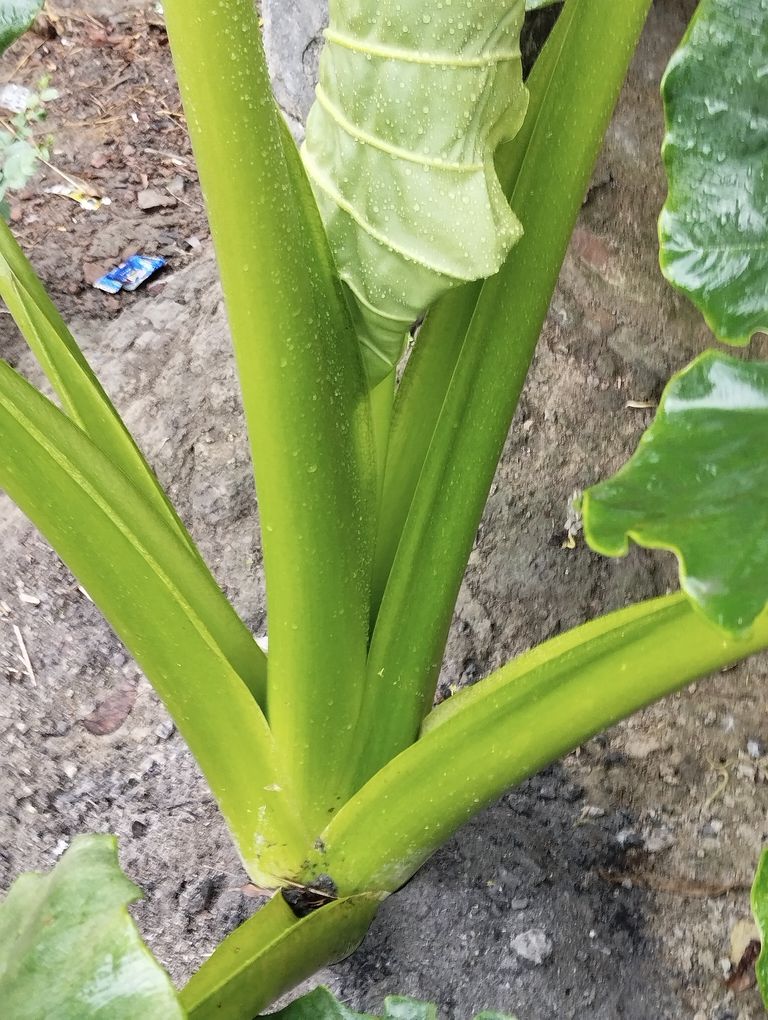
Introduction to Taro Colocasia esculenta Farming.
Taro (Colocasia esculenta), commonly known as "Kochu" in Bangladesh, is a widely cultivated root crop in tropical and subtropical regions. Its edible tubers and leaves make it an important food source rich in starch, vitamins, and minerals. In Bangladesh, taro is grown in almost all regions, particularly in low-lying and waterlogged areas. This blog will explore the step-by-step cultivation process of taro, highlighting the best practices to maximize yield.
- Climate and Soil Requirements for Taro Farming
Climate
Taro thrives in warm, humid climates. The ideal temperature for its growth ranges between 20°C to 30°C. It requires a long growing season with adequate rainfall or irrigation. Areas with annual rainfall between 1500mm to 2000mm are ideal for taro cultivation. The crop is sensitive to frost and cannot tolerate very dry conditions.
Soil
Taro grows best in well-drained loamy or clayey soils that retain moisture. Slightly acidic to neutral soils with a pH range of 5.5 to 7.0 are optimal for its growth. It can also be cultivated in waterlogged areas, making it suitable for regions prone to heavy rainfall or flood-prone areas.
- Varieties of Taro
There are several varieties of taro cultivated in Bangladesh. Some popular ones include:
Deshi Kochu: This is a native variety widely cultivated for its corms and stolons.
Mukhikachu: Primarily grown for its large edible corms, which are used in a variety of culinary dishes.
Pani Kochu: Grown in waterlogged or marshy areas, this variety is cultivated mostly for its stolons.
- Land Preparation for Taro Cultivation
To prepare the land for taro farming, follow these steps:
Plow the field thoroughly to make the soil loose and friable. Typically, 2-3 plowings followed by harrowing is sufficient.
Incorporate organic matter such as compost or well-decomposed cow dung to enrich the soil with nutrients. Around 10-15 tons of organic manure per hectare is recommended.
Level the field to ensure uniform water distribution, especially in areas that rely on irrigation.
- Propagation Method
Taro is propagated vegetatively using corms, cormels, or cuttings from the mother plant. Here's how you can propagate taro:
Corms: The large underground corms of the mother plant can be used for propagation. These are cut into pieces ensuring that each piece has at least one bud.
Cormels: Smaller corms or offsets that grow around the main corm can also be used for planting.
Stem cuttings: In some cases, taro is propagated using stem cuttings of the mother plant. This is more common for stolon-producing varieties.
- Planting Time and Spacing
Planting Time
The ideal time to plant taro in Bangladesh is during the pre-monsoon season, from March to May. For waterlogged varieties, planting can be done at the onset of the rainy season. Early planting ensures that the crop benefits from the monsoon rains.
Spacing
The recommended spacing for taro depends on the variety being cultivated. For corm-producing varieties, a spacing of 60 cm x 60 cm is ideal. For stolon-producing varieties, a closer spacing of 30 cm x 30 cm can be adopted. Proper spacing ensures good aeration and reduces competition for nutrients, leading to higher yields.
- Irrigation and Water Management
Taro requires consistent moisture for optimum growth, particularly in its early stages. Water stress can significantly affect both yield and quality. Here's how to manage irrigation:
Initial Stages: Ensure regular watering during the first 2-3 months after planting. Watering can be done once every 5-7 days depending on soil moisture levels.
Mature Stage: Once the plant matures and enters the tuber formation stage, reduce irrigation frequency. Over-irrigation at this stage may lead to rotting.
Rainfed Areas: In areas with sufficient rainfall, irrigation may not be necessary except during prolonged dry spells.
- Fertilizer Application
Taro is a nutrient-demanding crop. For best results, a balanced fertilization schedule should be followed:
Basal Dose: Apply a basal dose of nitrogen (N), phosphorus (P), and potassium (K) at the rate of 60:80:100 kg/ha before planting.
Top Dressing: Nitrogen can be applied in two split doses – one 30-40 days after planting and the second 60-70 days after planting. This will boost leaf growth and ensure healthy tuber development.
Organic Fertilizer: Along with chemical fertilizers, incorporating organic fertilizers such as compost or green manure can significantly improve soil structure and fertility.
- Weed Management
Weed control is crucial during the early stages of taro cultivation as weeds compete with the plants for nutrients and moisture. Regular weeding should be carried out during the first two months after planting:
Manual Weeding: Hand weeding or hoeing can be done at 20-30 day intervals, depending on weed infestation.
Mulching: Using organic mulch (such as straw or dried leaves) around the plants helps retain moisture and suppresses weed growth.
- Pest and Disease Management
Although taro is relatively resistant to pests and diseases, it is important to keep an eye out for the following:
Pests: Common pests include aphids, mites, and leaf hoppers. These pests can be controlled using organic pesticides or neem-based insecticides.
Diseases: Fungal diseases like leaf blight and corm rot can affect taro plants, especially in humid conditions. To manage these, avoid waterlogging and use fungicides like copper-based sprays.
- Harvesting
Taro is usually ready for harvest 6-9 months after planting, depending on the variety and growing conditions. Some indicators for harvesting include:
Corms: When the leaves turn yellow and begin to die back, the corms are mature and ready for harvesting.
Stolons: For varieties grown for stolons, harvesting can begin once the plant reaches maturity, and stolons are adequately sized.
The corms should be carefully dug out using a spade or hoe to avoid damaging them. Once harvested, the corms should be cleaned and dried for a few hours before storage or sale.
- Post-Harvest Handling
After harvesting, proper post-harvest handling is essential to maintain the quality and shelf life of taro:
Cleaning: Clean the corms thoroughly to remove soil.
Storage: Store the corms in a cool, dry place. In optimal conditions, they can be stored for 2-3 months.
Processing: In some cases, taro corms are processed into flour or chips for extended shelf life.
Conclusion
Taro farming can be a profitable venture if done with proper planning and care. By selecting the right variety, ensuring proper land preparation, maintaining adequate water supply, and managing pests and diseases, farmers can maximize their yields. Given its adaptability to a variety of soil conditions and its nutritional value, taro holds great promise for farmers in Bangladesh and beyond.
This guide provides a comprehensive overview of taro cultivation practices. If you're planning to start taro farming, following these steps can help ensure a successful and productive harvest.


The Benefits of Eating with Mindfulness: A Path to Health and Well-being
In today’s fast-paced world, it’s easy to rush through meals without giving much thought to what we’re eating or how it’s affecting our body. The demands of modern life often lead to mindless eating—grabbing a quick bite while multitasking, eating out of stress, or consuming food without fully experiencing it. However, an ancient practice called "mindful eating" has been gaining popularity for its numerous health and psychological benefits. Rooted in the principles of mindfulness, this approach encourages individuals to engage with food in a way that promotes both physical and emotional well-being.
Mindful eating is not a diet but a way of creating a positive relationship with food, paying full attention to the act of eating, and appreciating the sensory experience. By focusing on the present moment and being fully aware of what we consume, we can transform our eating habits and enhance overall health. Let’s explore some key benefits of mindful eating and why it is becoming an important practice in promoting a healthier lifestyle.
- Improves Digestion
One of the immediate benefits of eating mindfully is improved digestion. When we are fully present during a meal, we are more likely to chew our food thoroughly. Chewing is the first step in the digestive process and plays a crucial role in breaking down food into smaller particles, making it easier for the stomach and intestines to digest. Additionally, mindful eating encourages us to eat at a slower pace, allowing the digestive system to function more efficiently. This can help reduce common digestive issues such as bloating, indigestion, and heartburn.
When the body is in a relaxed state, the parasympathetic nervous system, often referred to as the “rest and digest” system, is activated. This system optimizes the digestive process by enhancing the secretion of digestive enzymes and improving nutrient absorption. By being present and calm during meals, we can create the ideal environment for the body to process food effectively.
- Helps with Weight Management
Many people struggle with weight management due to overeating or consuming calorie-dense, nutrient-poor foods. Mindful eating helps individuals become more aware of their hunger and satiety cues. By paying attention to the body's signals, we can distinguish between true hunger and emotional hunger. Emotional eating—consuming food in response to stress, boredom, or sadness—often leads to overeating and weight gain. Mindfulness allows us to recognize these patterns and make more intentional choices about when and what to eat.
Furthermore, mindful eaters are more likely to feel satisfied with smaller portions because they are fully immersed in the experience of eating. This sense of satisfaction can help prevent overeating and lead to healthier portion control, contributing to weight loss or maintenance over time. Research suggests that individuals who practice mindful eating are more successful at achieving and maintaining a healthy weight compared to those who follow restrictive diets.
- Enhances Enjoyment of Food
In a world where meals are often eaten on the go or in front of a screen, the joy of eating can be easily overlooked. Mindful eating encourages us to slow down and savor each bite, fully appreciating the flavors, textures, and aromas of the food. By engaging all of our senses, we can derive more pleasure from our meals, which can lead to a greater sense of satisfaction and fulfillment.
When we eat mindfully, we are more likely to choose foods that truly nourish our bodies and bring us joy, rather than mindlessly consuming whatever is convenient. This heightened awareness of our food choices can lead to healthier eating patterns, as we begin to crave foods that make us feel good both physically and emotionally. Ultimately, mindful eating transforms eating from a routine task into a pleasurable and meaningful experience.
- Promotes Emotional Well-being
Food and emotions are often closely linked, and many people use food as a way to cope with negative emotions. While indulging in comfort food occasionally is not harmful, relying on food to manage emotions can lead to unhealthy eating habits and emotional distress. Mindful eating helps break this cycle by encouraging us to confront our emotions in a non-judgmental way rather than seeking comfort in food.
Through mindfulness, we learn to recognize the triggers that lead to emotional eating and develop healthier coping strategies, such as meditation, deep breathing, or engaging in physical activity. This practice not only improves our relationship with food but also enhances our overall emotional well-being. By being more present in the moment, we can manage stress and negative emotions more effectively, reducing the likelihood of using food as an emotional crutch.
- Improves Relationship with Food
Many people have a complicated relationship with food, often marked by guilt, shame, or fear of overindulging. Diet culture can exacerbate these feelings by promoting restrictive eating habits that are unsustainable in the long term. Mindful eating shifts the focus from restriction and deprivation to enjoyment and nourishment. By paying attention to how food makes us feel, we can develop a healthier, more balanced relationship with it.
Mindful eating encourages self-compassion and kindness towards oneself, which can help alleviate feelings of guilt associated with eating certain foods. Instead of labeling foods as "good" or "bad," mindful eaters learn to listen to their bodies and make choices that support their overall well-being. This approach fosters a more positive attitude toward food and eating, reducing the stress and anxiety often associated with dieting.
- Reduces Binge Eating
Binge eating disorder is a common issue, characterized by consuming large amounts of food in a short period, often accompanied by feelings of guilt or loss of control. Mindful eating can be an effective tool in managing binge eating behaviors by helping individuals become more attuned to their body’s hunger and fullness signals. When we eat mindlessly, it is easy to ignore these signals and continue eating even after we are full.
By practicing mindful eating, we become more aware of when we are satisfied and can stop eating before reaching the point of discomfort. This awareness can help prevent episodes of binge eating and promote a healthier relationship with food. Over time, mindful eating can lead to more balanced eating patterns, reducing the frequency and severity of binge eating episodes.
- Encourages Healthy Food Choices
When we eat mindfully, we are more likely to make conscious choices about the types of foods we consume. By paying attention to how different foods make us feel, both physically and emotionally, we can begin to gravitate towards healthier options that provide sustained energy and nourishment. Mindful eaters often find that they naturally choose whole, nutrient-dense foods such as fruits, vegetables, whole grains, and lean proteins because these foods promote a sense of well-being.
In contrast, mindless eating often leads to the consumption of processed, high-calorie foods that provide little nutritional value. By cultivating mindfulness, we become more aware of the impact of our food choices on our health and well-being, leading to long-term improvements in our diet and overall health.
Conclusion
Mindful eating offers a powerful way to improve both physical and emotional well-being by fostering a healthier relationship with food. By focusing on the present moment and being fully aware of what we consume, we can enhance digestion, manage weight, and reduce emotional eating. Mindful eating also promotes greater enjoyment of food, helps prevent binge eating, and encourages healthier food choices. As a non-restrictive, compassionate approach to eating, it provides a sustainable path to better health and happiness.
Incorporating mindful eating into your daily routine may take time and practice, but the benefits are well worth the effort. By slowing down and paying attention to your body’s needs, you can transform your relationship with food and achieve a more balanced, healthy lifestyle.

Itching After Eating Taro Stems: Causes, Remedies, and Prevention
Introduction: Taro, locally known as "man kachu" in many parts of South Asia, is a popular ingredient in various dishes. Its stems and roots are widely consumed for their nutritional benefits. However, a common problem associated with taro stems is the itchy sensation some people experience after eating or handling them. This blog explores the reasons behind this reaction, remedies to alleviate the discomfort, and preventive measures to avoid itching altogether.
Understanding Taro Stems
Taro (Colocasia esculenta) is a tropical plant cultivated for its edible roots and stems. Both the root (corm) and the stem are consumed in many traditional recipes. The plant is rich in essential nutrients like fiber, vitamins, and minerals, making it a staple food in many cultures.
Despite its nutritional benefits, taro stems can cause itching when consumed or handled, especially if not cooked properly. This itching is primarily due to the presence of calcium oxalate crystals in the plant.
Why Do Taro Stems Cause Itching?
The primary cause of itching after consuming or handling taro stems is the presence of calcium oxalate crystals, also known as raphides. These needle-like crystals are abundant in taro and other plants from the Araceae family. When consumed raw or undercooked, these crystals can lodge in the skin, mouth, or throat, causing irritation and a prickly sensation.
Here’s a breakdown of why this happens:
- Chemical Composition: Taro contains high levels of oxalates, which are natural compounds found in various plants. When taro is not cooked properly, these oxalates remain intact and can cause irritation on contact with sensitive tissues.
- Contact Sensitivity: Some people may have heightened sensitivity to the oxalates present in taro stems. Even handling the plant can cause skin irritation in sensitive individuals. This is because the tiny oxalate crystals penetrate the skin, causing an immediate itch or burning sensation.
- Cooking Issues: If taro is not cooked thoroughly, the oxalate crystals are not broken down sufficiently. As a result, consuming undercooked taro can lead to a sensation of itching or burning in the mouth and throat.
How to Alleviate Itching
If you’ve eaten taro stems and are experiencing itching, there are several remedies to alleviate the discomfort:
- Gargling with Salt Water: If the itching is in your mouth or throat, gargling with warm salt water can provide relief. The salt helps neutralize the oxalates and reduce irritation.
- Lemon Juice: The acidity in lemon juice can help neutralize the oxalate crystals. If you experience itching in your mouth, drinking a small amount of lemon juice may help soothe the irritation.
- Cold Milk or Yogurt: Consuming cold milk or yogurt can provide relief from mouth and throat irritation. The coldness helps numb the affected area, while the dairy’s fat content can act as a barrier against further irritation.
- Baking Soda Paste: If your skin is itchy from handling taro, applying a paste made from baking soda and water can help soothe the irritation. Baking soda has a natural anti-inflammatory effect and helps neutralize the acids in oxalates.
- Aloe Vera: Aloe vera gel, known for its cooling and soothing properties, can also be applied to the skin to relieve itching. It is especially effective for skin irritation caused by direct contact with taro stems.
Preventive Measures
While the itching caused by taro stems can be uncomfortable, it’s usually preventable with proper preparation and handling. Here are some tips to avoid itching in the future:
- Thorough Cooking: Always cook taro stems thoroughly to break down the calcium oxalate crystals. Boiling taro for at least 15–20 minutes helps reduce oxalate levels significantly. Make sure the stems are tender and fully cooked before consuming them.
- Soaking in Water: Before cooking, soak taro stems in water for several hours. This helps leach out some of the oxalates, reducing the likelihood of irritation.
- Adding Acidic Ingredients: Cooking taro with acidic ingredients like tamarind, lemon juice, or vinegar can help neutralize oxalates. These acids break down the calcium oxalate crystals, making the taro safer to consume.
- Wearing Gloves: If you are sensitive to taro, wear gloves while handling or preparing the stems. This will prevent skin contact with the oxalate crystals, reducing the risk of itching.
- Use of Coconut Oil: Applying coconut oil to the hands before handling taro can provide a protective barrier. The oil helps prevent the oxalate crystals from coming into direct contact with the skin.
Nutritional Benefits of Taro Stems
Despite the potential for itching, taro stems are highly nutritious and should not be overlooked as a valuable part of the diet. Here are some key benefits:
Rich in Fiber: Taro stems are an excellent source of dietary fiber, which promotes healthy digestion and helps prevent constipation.
Vitamins and Minerals: Taro is rich in essential nutrients like vitamin C, vitamin E, potassium, and magnesium, all of which contribute to overall health and wellness.
Antioxidants: The plant contains powerful antioxidants that help protect the body from free radical damage, reducing the risk of chronic diseases like heart disease and cancer.
Conclusion
Taro stems, though a nutritious and tasty addition to many dishes, can cause itching if not handled or cooked properly. The irritation is primarily due to the presence of calcium oxalate crystals, which can cause discomfort when consumed or touched. However, by taking simple preventive measures such as thorough cooking, soaking, and using acidic ingredients, the risk of itching can be minimized. If itching does occur, home remedies like gargling with salt water or applying baking soda paste can provide relief. With proper preparation, you can enjoy the numerous health benefits of taro stems without the discomfort.
